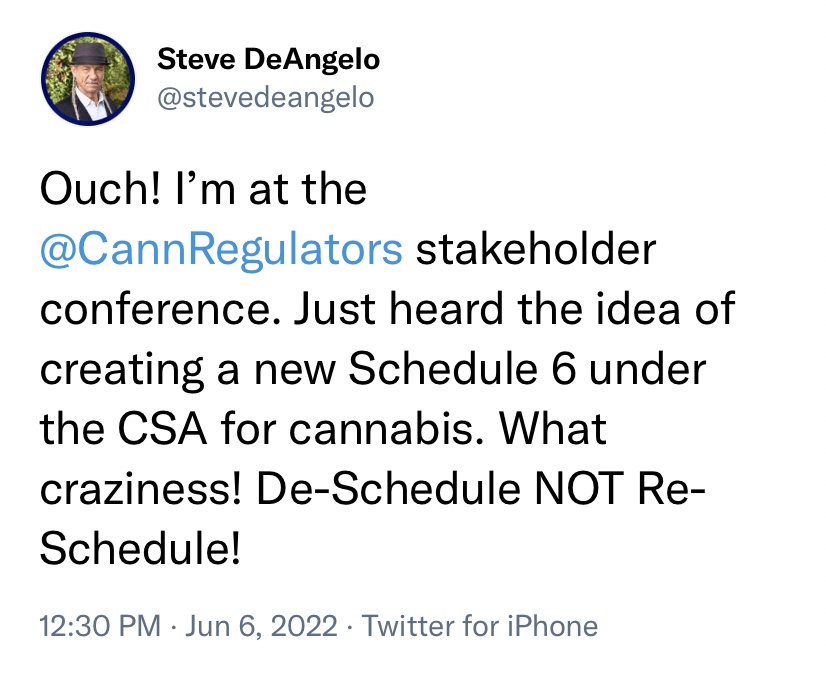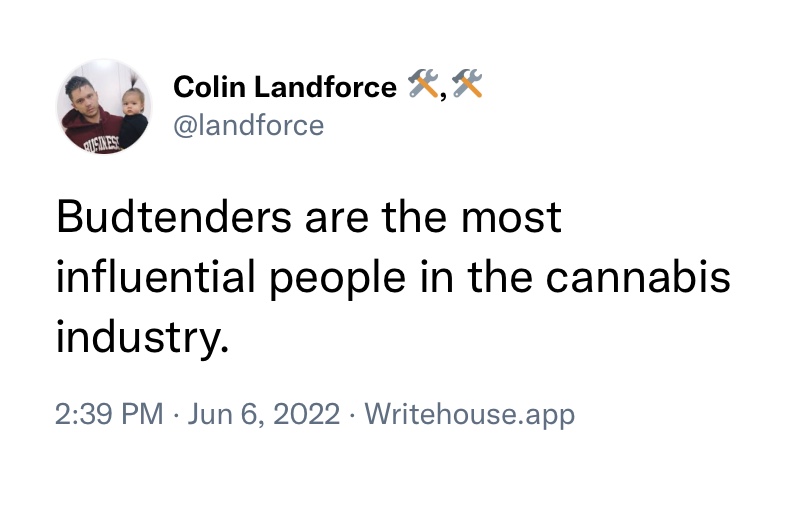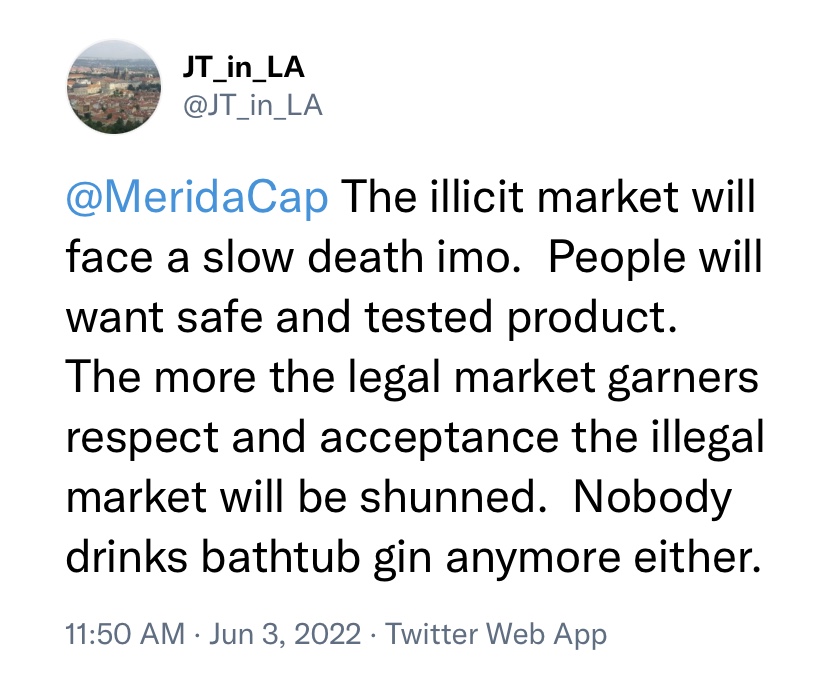07 June 2022 | Cannabis
Rescheduling cannabis, the budtender’s influence, and the illicit market.
By Jay

The Drug Enforcement Agency (DEA) currently has five categories of substances, with cannabis currently listed as a Schedule I.
The drugs on the scheduled substances list are in order from most dangerous and addictive to least dangerous and addictive.
This means cannabis is currently listed as among the most dangerous and addictive drugs as a schedule I substance – with “no currently accepted medical use”.
It’s almost laughable, considering the United States’ billion-dollar medical cannabis program.
Now they want a whole new category for cannabis, apparently – schedule VI. Is cannabis not dangerous enough for 1-5? I guess we need a whole new category…
Some states already categorize cannabis as a schedule VI substance, but as we know, state and federal law don’t always agree.
The DEA’s website says Valium, Xanax, and Ambien have “a low potential for abuse and low risk of dependence.”
Anyone who has been near any of these substances knows this is untrue, especially if you know someone who has battled substance abuse.
Also, anyone who has even a sliver of access to the internet. Take a look at these stats:
- More than half a million people in the U.S. are currently abusing Ambien – and I bet this number was even higher 10 years ago when Ambien was prescribed more often.
- 4 million of the 17 million Americans prescribed Xanax abused it in 2015. This is more than Valium, Klonopin, and Ativan misusers combined.
- More than 20 million Americans over the age of 20 had abused Valium at some point in their lifetime, according to a 2011 survey.
So, misuse and abuse are alive and well with these drugs – and many more. Yet, the DEA says the risk is low.
But, the risk of addiction and harm is high, nearly guaranteed with cannabis, says the DEA. Until 2018, they said the same thing about hemp, too.
This is the very reason why cannabis businesses face so many barriers. Because cannabis is a Schedule I substance. Schedule I substances are, for all intents and purposes, illegal outside of research.
This is why cannabis businesses can’t take out traditional business loans. It’s why they can’t claim ordinary business expenses on their taxes or file for bankruptcy. It’s why health insurance won’t cover the cost of medical cannabis. It’s why cannabis professionals are denied home loans. It’s why operators’ bank accounts are closed down without warning. It’s why Facebook and Instagram boot us off every other week.
And on and on and on it goes.
What I’m thinking 🧠
I think the fed’s entire drug classification system is insane, to be honest. I think that is something we can all agree on.
But, if rescheduling cannabis to a Schedule VI is the quickest way to stop the bleeding for U.S. operators: I’m all for it. Clearly, it’s not ideal. It’s asinine beyond belief, but this isn’t the hill to die on while the legal market crumbles under these regulations.
My concern is keeping American operators afloat. If a Schedule VI classification is the fastest way to help them: let’s do it. And from there, we can work to remove it from the list of scheduled substances entirely.
Budtenders make or break this industry

Matt O’Brien, who started The Green Paper (formerly Four PM), strongly believes budtenders are the most influential people in the cannabis industry, and clearly, other people do too.
Budtenders are often the only person of contact consumers have with the cannabis industry, especially new consumers who might not be intertwined in the cannabis community. This even rings true for some seasoned consumers.
If a consumer, or even medical cannabis patient, has a question – they ask their budtender.
Budtenders are literally bridging the gap from business to consumer. They are the medium that does that.
This means budtenders are often viewed as “the face” of retailers or cannabis brands. Budtenders are a physical representation of that operation’s beliefs and value systems. If you hire someone, you are saying “we agree with how this individual carries themselves and how they handle business interactions on our behalf.”
A good experience with your budtender says “this company cares about me. I want to return”, while a bad experience says “I’ll never come back.”
All cannabis retail bad experiences aren’t because of the budtender. But, you can bet that all bad experiences with your budtender are remembered.
People remember how people treat them – tech glitches and out-of-stock products can be forgiven. Poor treatment can’t.
78% of consumers (in a traditional setting) have ditched a transaction they were about to make because of a poor customer service interaction.
The right budtenders prevent that from happening and it’s on the operators to make sure budtenders feel supported in their role.
Additionally, budtenders can help shape the consumer’s perspective. That Indica, Sativa, hybrid classification we all hate so much, because it doesn’t tell the full story?
Budtenders can be the ones to help educate consumers and formally move us away from that.
Also, budtenders are often the first to see consumer trends develop. Their perspective can help shape business decisions about product launches and future plans.
Budtenders are the window to our industry and can offer perspectives from both sides of the fence.
What I’m thinking 🧠
At a high level, there’s still a gap between the consumer and the budtender. Budtenders often don’t have a protocol to recommend products to consumers, much less medical cannabis patients.
Many of them just follow the Indica/Sativa/hybrid model and trust which one of those words is written on the package.
That approach won’t give consumers what they need, but operators are the ones that have to enforce a new way of thinking for budtenders.
As Colin also said in his Tweet replies, cannabis products are complex. Oftentimes, each one is vastly different, too. A lack of transparency from brands and the general complexity of each product can make it hard for budtenders to recommend products, too.
In my opinion, we need to overhaul everything we know about hiring and retaining budtenders – starting with increasing the salary and revamping training procedures.
Is the illicit market done for?

The legal cannabis industry is a double-edged sword. On one hand, it offers brands the chance to be part of something bigger. Consumers can be part of a community and go to trade shows, host events, and more.
On the other hand, most of us just want to be able to grow a few plants at home and be left alone about it. We don’t need the fanfare that the legal cannabis industry provides, though I have to admit it’s a ton of fun.
American federal law currently calls this illegal. Growing plants at home. Certain states allow it, but it’s prohibited at the federal level. This of course includes gifting homegrown cannabis and selling it on the side.
It’s hard to tell what this person is considering the illicit market, but they say it’ll be ditched in favor of a “safe and tested product.” This person says the illegal market will be shunned and compares it to drinking bathtub gin.
While I think the delivery is harsh, I do agree with the principle of what he’s saying. On a large scale, illegal cannabis will be phased out and people will opt for tested products.
But, we’ll never be able to stop the gifting economy in the cannabis space or home cultivators – and why the heck should we? We don’t tell friends and family to not gift tomatoes or spices. Cannabis is no different.
However, I have a feeling that’s not really what this tweet is referring to. It’s referring to the fact that the illicit market is swallowing the legal market whole.
California’s industry, for example, literally cannot compete with the illicit market. The state’s illicit market generated approximately $8.7 billion in sales in 2019, while the legal market saw just $3.1 billion.
California’s insane barriers prevent people from bringing products to market. It also prevents them from marking them at a reasonable price, as it cost so much to even get the product on the shelves. Profits are razor-thin, even with expensive products.
This isn’t a problem in the illicit market, where there are no regulations and taxes, so consumers stay with the same guy that’s been serving them for 10+ years.
What I’m thinking 🧠
There will always be an “underground” cannabis culture, in my opinion. And I think we should do everything we can to hold onto that.
But, I do think most consumers will transition towards legal purchases as prices drop and regulations ease up. While I don’t necessarily foresee us shunning the illicit market, I see it playing a much smaller role in the future than it does now.